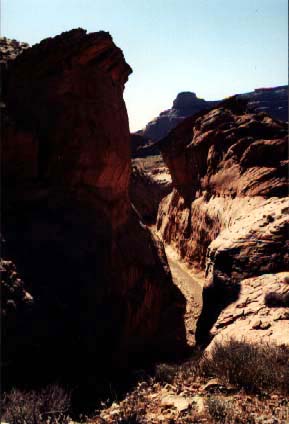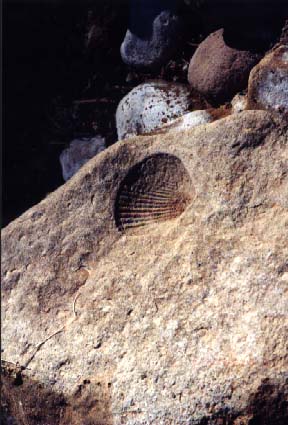By Dave Webb 
Imagine going to Lake Powell and not seeing another boat on the water! Imagine hiking in the Powell area when the air temperature is mild and the desert is inviting!
That's the experience we enjoyed over President's Day weekend (Feb. 13-15, 1999). We launched at Wahweap and boated some 35 miles up to Rock Creek Bay - never seeing another boat after we left the marina.
We camped at the water's edge in the back of Dry Rock Creek - one of the most beautiful camping spots on the lake. The view was remarkable. From camp we could see the wide bay and some of its narrow, twisting canyons, flanked by sheer sandstone cliffs contorted into interesting shapes. A massive rock, balanced on a tiny pedestal, stood watch over us from the ridge above camp. Natural arches decorated the nearby cliffs.
The air temperatures reached 55 during the day - very pleasant. The teenage boys in our group took their shirts off and soaked up the sun's rays.
Temperatures were very pleasant for hiking. But it did feel chilly traveling rapidly across the water. Boating was comfortable if we wore a jacket and stayed behind the windshield.
Nights were chilly. It was cold enought to freeze water at night, but we stayed snug inside good tents and warm sleeping bags. Nights were long. The sun set about 5:30, and it got dark just after 6 p.m. The kids sat around the campfire and acted crazy for a couple hours, then wore out and went to sleep. Imagine getting 8-10 hours of sleep while camping with teenage boys. Incredible!
I'd heard that Dry Rock Creek offers an interesting hike, and I decided to give it a try. It was great. The air was warm enough that we hiked in shirt sleeves, carrying a light jacket. Dry Rock Creek makes a good winter or early spring hike because it is dry - no wading necessary. Its not a good canyon to hike in the summer, when air temperatures soar up toward 110 degrees and you want to stay in the water or in the shade. (There are a few canyons at Powell which provide excellent summer hikes. We'll describe them in future issues.)
 Dry Rock Creek offers one narrows section after another. It cuts through very rugged country as it makes its way from Fifty-Mile Mountain down to the lake. Our goal was go get up under the high cliffs which define the edge of the mountain. We didn't make it very far. We hiked for a couple hours, wore out our winter-softened bodies, then climbed up on a ridge to take a GPS reading. We'd only gone about a mile-and-a-half! We hiked for another hour, then decided we'd better start back or we wouldn't make it before the long, dark night set in.
Dry Rock Creek offers one narrows section after another. It cuts through very rugged country as it makes its way from Fifty-Mile Mountain down to the lake. Our goal was go get up under the high cliffs which define the edge of the mountain. We didn't make it very far. We hiked for a couple hours, wore out our winter-softened bodies, then climbed up on a ridge to take a GPS reading. We'd only gone about a mile-and-a-half! We hiked for another hour, then decided we'd better start back or we wouldn't make it before the long, dark night set in.
Dry Rock Creek is a fascinating study in erosion. It is cut through slickrock, with beautifully shaped sandstone walls and a sandstone floor. It's never very deep but it's quite scenic.
Floods have carried boulders and debris into the canyon from the mountainside. Massive boulders, along with smaller rocks and soil. In many places debris clings to the slickrock walls and sits on top the cliffs, precariously waiting until a nudge from Mother Nature sends it crashing down the canyon.
This is a dangerous canyon during stormy weather. It drains an extensive area, including much of the top of the mountain. Rain anywhere in the area is channeled into the canyon and through the narrows – where there is no place for a hiker to hide. Rain also brings a danger from rockslides.
These factors all contribute to the intrigue of the canyon. The debris brought down by floods and rockslides provide clues about the character of the land drained by the canyon - about the top of Fifty-Mile Mountain and the adjacent ridges.
The debris in the canyon is composed of a jumble of rock types. Flint and quartz and gypsum and various sandstones. A particular kind of mudstone is common and it is full of fossils. Shells are the most visible, but other small marine animals can also be seen.
A worker at Wahweap told me a mastodon skeleton had been uncovered in upper Dry Rock Creek.
There are undoubtedly Anasazi ruins in the upper part of the canyon, but we did not stumble onto any during this trip.
It's a fascinating area, well worth exploring. You could wander for a week in the drainage and never see it all.
We enjoyed a great winter outing. It was hard to come back, knowing the weather forecast called for rain turning to snow along the Wasatch Front. Now I'm anxious for warm weather and more trips to Powell.

